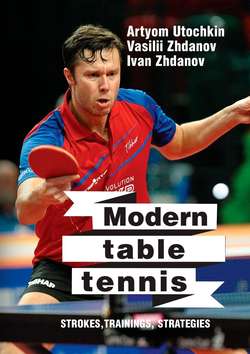Читать книгу Modern table tennis: strokes, trainings, strategies - Artyom Utochkin - Страница 14
Different variations of the forehand top-spin
Variation #5. Counter-loop on the right side of the table (in the near zone)
ОглавлениеThe forehand counter-loop on the table is very different from all components of the forehand counter-loop from the middle zone. That is why we assign it to a separate variation.
This element is also called the “interception of an attack” “or “twisting”. By the way, the most interesting thing is that in some cases, it is more logical to say “tackle/interception” and in other, more appropriate would be the word “twisting”.
For example, when you perform a forehand counter-loop on the table by first attacking move of your opponent, it is better to call the counterattack as “interception”. As you would seize the initiative, which your opponent was trying to take over. And when a mutual counter-loop game began on the table, it is better to call it “twisting” or “twist against twist”.
Now let’s talk about the technical part of the counter-loop to the right on the table. The main difference of this element is that it is performed much earlier than the highest point of ball rebound, it is executed on the bottom-up ball, at the moment when the ball is only gaining height.
Also, this element is performed very close to the table. Closer than all other variations of top-spin, used in the rally.
Why do you need to play bottom-up ball closer to the table during this element?
The meaning of this element that you are also using speed and spin of the ball you receive, in other words, you do not add your power and spin, but use the one that was input by the opponent.
When performing this element, the inclination of the racket is slightly more closed than in the classic top-spin from the block. Especially it is necessary to draw attention to the fact that at the time of the racket passing through the ball, you don’t have to play it hard.
In table tennis, there are concepts – “game ball” and “the ball game”. Let’s study them.
“The ball game” is when maximum rotation is added to the ball due to the rubber grip, i.e. the blade does not mostly participate in such game. We can say that this is a more gentle, “sliding” ball handling.
The best example of the ball game is chop. If a tough clash occurred between racket and a ball, it is called a push, rather than a chop. Qualitative chop is when the lining “slips” along the ball, adding maximum rotation to it, but not adding any speed.
The same principle is used for interception. The rubber “slips” greatly on the ball and it does not receive an excessive rigidity.
“The game ball” is, as you guessed, the opposite of “ball game”. Here, by contrast, comes a tough game ball, rubber is forced under ball’s pressure and we actually feel the blade participating in the element.
The best example of a ball game is a final smash without rotation (which, incidentally, is very rarely used in pure form in today’s table tennis).
We have elaborated on the moment when racket passes through the ball because this point is critical when performing counter-loop on the table. Once you play the “ball” hard – your “interception” immediately flies over the table.
Few words about the movement itself. Correct swing is very important for performing the “interception” and “twisting”.
Since we use the speed and spin of the received ball standing close to the table, when implementing this element, we need a much shorter backswing. The hand starts its movement, not going below the table level. It stays bent at the elbow.
Legs and pelvis also do not go down and sideways, the athlete‘s position is neutral. The core is turned a little bit when performing backswing.
While performing this element the slope of the bat is slightly more closed compared to the basic version of the forehand topspin against the block.
Let’s dwell on the moment of passing the racket through the ball. As mentioned above, the racquet “slips the ball” more than “strokes” it. But the speed of the racket passing through the ball is also important here. The racket should be ahead of the ball, of course, in fact, it’s impossible, but you must support this desire. If you will try to get ahead of the ball in the moment of touching between the racket and the ball, the ball will lie on a table. But if the racket would pass through the ball with the lack of speed, the ball flies off the table because you do not have time to block the rotation that you receive.
